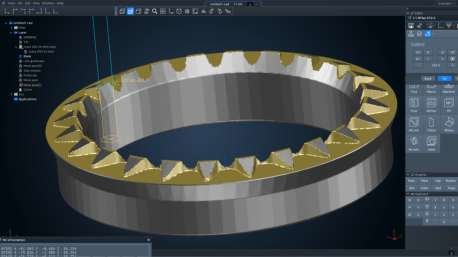Maximizing Efficiency and Precision: A Comprehensive Guide to Adaptive Roughing Strategies

In the ever-evolving landscape of computer-aided manufacturing (CAM), adaptive roughing strategies have emerged as powerful tools for optimizing material removal rates, reducing machining time, and enhancing surface finish quality. Adaptive roughing strategies leverage advanced toolpath algorithms and dynamic machining parameters to adaptively remove material from workpieces, maximizing efficiency while minimizing tool wear and cutting forces. In this comprehensive guide, we’ll delve into the intricacies of adaptive roughing strategies, exploring their importance, benefits, implementation methods, challenges, and best practices.
Understanding Adaptive Roughing Strategies
Before delving into the details of adaptive roughing strategies, it’s essential to grasp their fundamental principles and objectives. Adaptive roughing strategies aim to optimize the material removal process by dynamically adjusting cutting parameters such as feed rate, depth of cut, and stepover distance based on the geometry of the workpiece, cutting tool characteristics, and machine tool capabilities. Unlike traditional roughing approaches that utilize constant parameters and predefined toolpaths, adaptive roughing strategies adapt to varying material conditions and tool engagement, resulting in more efficient chip removal, reduced tool wear, and improved surface finish.
Importance and Benefits
Adaptive roughing strategies offer several key benefits that make them indispensable for modern machining operations:
- Increased Material Removal Rates: By dynamically adjusting cutting parameters, adaptive roughing strategies enable higher material removal rates compared to traditional roughing approaches, reducing machining time and increasing productivity.
- Extended Tool Life: Optimized tool engagement and reduced cutting forces result in less tool wear and longer tool life, leading to cost savings and reduced tooling expenses.
- Improved Surface Finish: Adaptive roughing strategies minimize tool deflection, vibration, and chatter, resulting in improved surface finish quality and reduced post-processing requirements.
- Enhanced Machining Efficiency: By maintaining constant chip load and optimizing toolpath trajectories, adaptive roughing strategies minimize air cutting and optimize toolpath efficiency, maximizing machine tool utilization and energy efficiency.
Implementation Methods
Implementing adaptive roughing strategies involves several key steps and considerations:
- Toolpath Generation: Adaptive roughing toolpaths are typically generated using specialized CAM software that incorporates algorithms for adaptive toolpath generation and dynamic parameter adjustment.
- Workpiece Analysis: Before generating toolpaths, it’s essential to analyze the geometry, material properties, and machining requirements of the workpiece to determine optimal cutting parameters and toolpath strategies.
- Parameter Optimization: Fine-tuning cutting parameters such as feed rate, depth of cut, stepover distance, and spindle speed is crucial for achieving optimal material removal rates, surface finish, and tool life.
- Tool Selection: Selecting appropriate cutting tools with the right geometry, material, and coating is essential for maximizing performance and reliability in adaptive roughing operations.
- Simulation and Validation: Before machining, it’s advisable to simulate adaptive roughing toolpaths to verify toolpath trajectories, cutting conditions, and material removal rates, ensuring compatibility with machine tool capabilities and workpiece requirements.
Challenges and Considerations
While adaptive roughing strategies offer significant advantages, they also present several challenges and considerations:
- Algorithm Complexity: Implementing adaptive roughing algorithms requires advanced mathematical modeling, computational techniques, and algorithmic optimization to achieve efficient and reliable toolpath generation.
- Machine Tool Compatibility: Not all machine tools are capable of executing adaptive roughing toolpaths due to limitations in spindle speed, feed rate, acceleration, and dynamic response characteristics.
- Toolpath Verification: Verifying adaptive roughing toolpaths requires specialized simulation software and computational resources to accurately predict tool engagement, cutting forces, and material removal rates.
- Material Considerations: Adaptive roughing strategies may not be suitable for all materials, especially those with varying hardness, toughness, and machinability characteristics, requiring careful selection of cutting parameters and toolpath strategies.
- Operator Training: Adopting adaptive roughing strategies may require training and expertise in CAM programming, toolpath optimization, and machining simulation to maximize effectiveness and reliability.
Best Practices for Adaptive Roughing
To ensure the successful implementation and utilization of adaptive roughing strategies, manufacturers should adhere to best practices:
- Start with Small Steps: Begin by implementing adaptive roughing on simpler parts or less critical components to gain familiarity with the process and assess its effectiveness before scaling up to more complex or high-value workpieces.
- Collaborate with Tool Suppliers: Work closely with cutting tool suppliers to select appropriate tooling solutions and obtain recommendations for cutting parameters, toolpath strategies, and toolpath optimization techniques.
- Continuous Monitoring and Optimization: Regularly monitor machining performance, tool wear, surface finish quality, and productivity metrics to identify opportunities for further optimization and refinement of adaptive roughing strategies.
- Invest in Training and Education: Provide training and education to CAM programmers, machinists, and operators to enhance their understanding of adaptive roughing concepts, techniques, and best practices.
- Stay Updated with Technology: Keep abreast of advancements in CAM software, machine tool technology, cutting tool materials, and machining processes to leverage the latest innovations and opportunities for improvement in adaptive roughing operations.
Applications and Case Studies
Adaptive roughing strategies find applications across various industries and machining processes:
- Aerospace Manufacturing: In aerospace machining, adaptive roughing strategies are used to efficiently remove material from complex structural components such as aircraft wings, fuselage sections, and engine components.
- Automotive Production: In automotive manufacturing, adaptive roughing is employed to rough out intricate automotive parts such as engine blocks, transmission housings, and chassis components with tight tolerances and high material removal rates.
- Die and Mold Making: In die and mold making, adaptive roughing strategies help optimize material removal from hardened tool steels, carbide inserts, and other tough materials used in the production of injection molds, die casting dies, and stamping dies.
- General Machining: In general machining applications, adaptive roughing strategies are used to efficiently rough out various components, including prototypes, fixtures, and one-off parts, across a wide range of industries and applications.
Conclusion
In conclusion, adaptive roughing strategies represent a paradigm shift in modern machining, offering unparalleled efficiency, precision, and productivity in material removal operations. By leveraging advanced toolpath algorithms, dynamic parameter adjustment, and optimized toolpath trajectories, manufacturers can achieve significant improvements in machining performance, tool life, surface finish quality, and overall productivity. By adhering to best practices, addressing challenges, and embracing the opportunities presented by adaptive roughing, manufacturers can unlock new levels of efficiency and competitiveness in today’s fast-paced manufacturing landscape. Master the art of adaptive roughing, and revolutionize your machining capabilities for the future.




